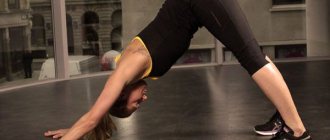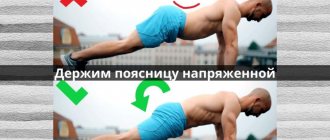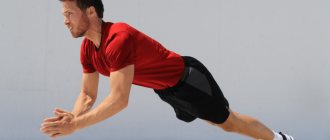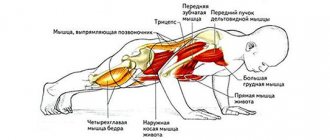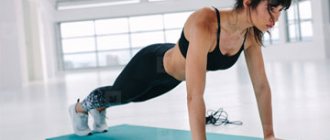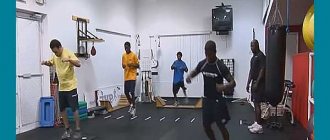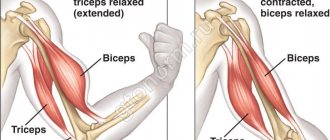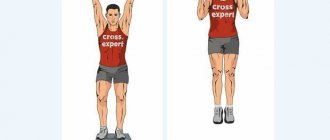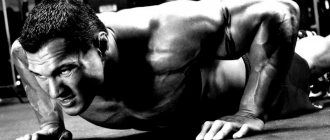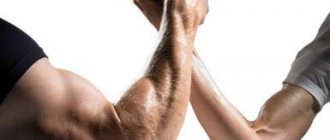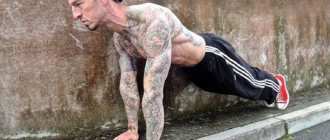Types of push-ups:
- Regular push-ups;
- With a chic position of the hands;
- On fists;
- On one hand;
- On fingers;
- "Three dots";
- Circular;
- With weights;
- From the bench.
Let's look at all types of push-ups
I. Regular push-ups
The muscles of the chest, triceps, and shoulder girdle are involved. It is in them that you will feel a slight pleasant pain after the first sessions.
You should take a lying position with your hands shoulder-width apart. With a straight back and tummy tucked in (this is very important for proper execution and high-quality results!). Then lower yourself down, touch your chest to the floor, hold for a while and return to your original position. And so you repeat the number of times you have chosen.
II. Push-ups with wide arms
Effective muscles - chest, shoulder girdle, triceps.
Take a position - lying down. Place your hands very wide - at a distance that is ten to twelve centimeters greater than the width of your shoulders. As you exhale, lower your chest and touch the floor. Stay for a while and return to the primary position. There is another secret to the speed and quality of the results from the exercise - never do push-ups quickly, this will only lead to worse heart function and your muscles will become clogged. With slowness, good muscle pumping occurs.
III. Push-ups with fists
Push-ups with fists are not considered difficult, as it might seem at first glance. We don’t argue that at first the bones in your hands will ache, and the skin in these same places will become rougher. But your hands will be truly masculine, and the results from training with this particular method will not be long in coming. In fact, a similar hand position helps develop the muscles of the fingers, and the fist gets positioned when striking. Fist push-ups are often used in martial arts training (as you understand, for good reason).
We provide you with types of push-ups on fists:
- hands pressed to the body, chest level, emphasis on fists with palms facing inward;
- the arms are spread out from the body by ninety degrees, the position is higher than the chest, resting on the fists with the palms down.
Finally, you should take the starting position - lying down. Palms shoulder-width apart and clenched into fists. In order for you to feel comfortable doing push-ups on your fists in the future, you should just stand on your fists in the starting position for a few minutes, and only then, as you exhale, go down and touch the floor with your chest. And return to the starting position.
IV. One-arm push-ups
Quite difficult push-ups, since all the emphasis falls on the 1st hand. Here you pump up your pectoral muscles, abs, and triceps. To perform, you need to take a lying position and move your 1st leg to the right. Next, transfer the body weight to one arm, and bring the other behind your back. With your back straight and your tummy pulled in (don’t forget about this), as you exhale, we go down. We pause for a certain number of seconds and return to the starting position. Change hands and do it again.
V. Push-ups on the fingers (Leopard paw)
This category is considered a difficult method and this is true.
After all, standing on your fingers, transferring all your weight to them, is incredibly difficult. It is worth noting that it must be done diligently so that the phalanges of the fingers are straightened to the end or slightly rounded upward, otherwise there is a possibility of damaging them and bruising the whole body. The method of execution is elementary. The starting point is the same as in the usual form. We rest our hands on the floor at the width of your shoulders, emphasis on your fingers. Not forgetting about a straight back and a retracted stomach, when exhaling we descend, hold for a couple of seconds and return to the original position.
VI. Three-point push-ups
This type is very complex. The muscles of the chest, shoulder girdle, triceps, buttocks are the muscles involved during push-ups. And this is good - after all, everyone can be the owner of a toned, elastic heel.
Lying emphasis. Place the toe of the first foot on the heel of the other. Then, as you exhale, descend, hold for a while and return to the starting position. Change leg and repeat.
VII. Circular push-ups
In this type of push-up, the emphasis is on the back and abdominal muscles. Greater overload is placed on the pectoral and deltoid muscles, as well as triceps.
Lying down, hands placed slightly wider than shoulders and at chest level. As you inhale, move your body weight to the 1st hand and, going down, to the other hand. Then, as you exhale, rise up. Return to standard position. Do it again in a different direction.
VIII. Weighted push-ups
This type of push-up has the greatest degree of difficulty. There are weights that you may still need when doing pull-ups and dips. If the possibility of acquiring is excluded, fill your backpack with weights.
IX. Push-ups from a bench
More precisely, reverse push-ups. When performing them, the triceps, pectoral muscles and anterior deltoids are involved. Lying down, hands on the edge of the bench next to your hips. Move off the bench so that the support is on your arms and legs. There should be a ninety-degree angle between your legs and hips, with your legs parallel to the floor. As you slowly descend, keep your shins perpendicular to the floor. Then we return to the starting position.
What are push-ups even for?
Despite the apparent simplicity of this exercise, it is highly effective and can pump up all the muscles responsible for the work of a boxer. Moreover, push-ups affect not only the muscles of the arms, shoulders, chest, but also the heart muscle. And, as you know, you can’t go far in boxing without endurance. There is a certain axiom: the lighter the weight of the opponents, the more punches they throw per round. On average, a boxer throws from 60 to 100 punches in three minutes. Imagine what kind of endurance you need to have to hold out for at least a minute without dying from exhaustion! Any beginner who comes to the boxing gym, after just a few minutes of working on a heavy boxing bag, definitely feels that his arms and shoulders are literally falling off
. And all this is due to untrained muscles. So let's learn push-ups together.
Push-ups are the basis of any boxing workout.
Coach Teddy Atlas
Boxer training in the gym
Dips
Dips are considered the most common outdoor exercise. The shoulder girdle, triceps, and pectoral muscles develop. There are a number of varieties of dips.
Types of push-ups on parallel bars:
Hanging on parallel bars, supporting on parallel bars, handstands, push-ups with a reverse grip, push-ups with the body shifted to the right, left, etc.
The load on muscle groups depends on the depth of lowering and the angle of inclination:
- For the pectoral muscles - we lower ourselves deeply, bend our body forward, and spread our elbows to the sides;
- For triceps - the body is straight, the arms are pressed to the body, the legs are straight.
The leading rules for performing exercises on the uneven bars:
The position must be correct. The legs are crossed and the knees are bent, forming a ninety-degree angle. The exercise should be performed slowly, without jerking. When lowering, the angle of the shoulder and forearm must be ninety degrees. When doing push-ups, the muscles should be in constant tension (this will increase the load). And be sure to watch your breathing, it must be correct: when you go down, exhale, when you go up, inhale. When doing push-ups on the uneven bars, you need to clearly understand what exactly you are focusing on - developing muscle strength or increasing them.
In the first case you should:
- quickly lower and slowly raise the body;
- increase the number of approaches and repetitions;
- keep muscles tense when lifting;
- reduce the time between approaches;
- 1 time per week, do as many push-ups as possible.
Clapping Push-Ups for Explosive Strength
Spartan push-ups or clap push-ups are the best workout for developing explosive strength. This exercise is also called plyometrics.
. The essence of this training is to develop strength and speed qualities, which involve increasing explosive power to strike with maximum speed and amplitude. It’s easy to do - push off the floor as hard as you can, then make a clap and again stand upright while lying down. Then push-ups, and the cycle repeats.
This exercise is the best friend of your pectoral muscles.
And if you pump up, and such a push-up becomes commonplace for you, then it can be complicated. To do this, clap your hands behind your back and you will understand how difficult it is.
The meaning of execution
Push-ups for boxers are the first thing that both beginners and professionals do during strength training. There are several options for push-ups for different muscle groups. There are no restrictions on the number of repetitions and approaches in this exercise. If necessary, you can use weights. It is only important to do push-ups correctly and breathe correctly, look at the photo.
The classic position is that your arms are slightly wider than your shoulders, your feet are pressed together, your torso, pelvis and legs are perfectly straight, like a board, your head is not lowered. When lowering down, your chin and chest should touch the floor. When raising the body, inhale, while lowering, exhale.
Push-ups for boxers are good because they load:
- Pectoral muscles;
- Triceps;
- Forearms;
- Deltoid muscles;
- Muscles of the lower back;
- Quadriceps.
If you place your legs above your head (a bench or chair is suitable for this purpose), the load moves to the arms, upper chest muscles and deltoids.
Exercising at home
In fact, in order to bring your physical condition back to normal, you can do a set of different exercises right at home. It is important to do tasks correctly and constantly, to moderately increase the load. So, in cramped conditions it is quite possible to do:
- jump squats. You can take weights;
- various types of push-ups listed above;
- pull-ups on the horizontal bar and push-ups on the uneven bars;
- cross-country to increase endurance;
- strengthening the shoulder joint with an expander;
- performing the “corner” exercise to strengthen the torso;
- stretching the ligaments for full strikes with both hands and feet;
- neck pumping on the bridge.
Thus, with constant push-ups from the floor, the following muscle groups develop:
- shoulders;
- triceps;
- latissimus, upper and middle muscles of the chest;
- press.
In some cases, when there are problems in the lumbar area or it is simply weak, unpleasant sensations arise in this area during push-ups. Some trainers recommend building a muscular skeleton, i.e. just pump up your lower back muscles. Hyperextension is suitable for this - lie on your stomach, secure your legs (let someone hold them on top) and lift your body up, trying to see the ceiling.
Slow push-ups are the basis of everything
A person who has been in the army probably knows what a “one and a half” team is! and how hard it is to do it. And any boxer knows that one of the hardest exercises for developing a fighter’s explosive power is slow push-ups. The essence of the exercise is as follows: you stand upright while lying down, lower your torso as slowly as possible to the floor level. Ideally, you should touch your chest to the floor. Lock this position and push upward from the floor with force. To achieve results, you need to perform 3 sets of five times at least. This is the most correct way, and you will see the result very soon.
The body must be kept straight
How to do push-ups better with your fists
Push-ups on your fists have a number of undoubted advantages for a fighter over regular push-ups on your palms. This is, firstly, the opportunity to do push-ups more deeply and better work the chest and triceps, and secondly, this is done simultaneously with strengthening the striking knuckles.
The correct position of the fist when doing push-ups: the main load falls on the first two knuckles - the index and middle fingers; A common mistake is that the load is distributed on the last three dominoes, excluding the load on the first. Rarely does anyone succeed in standing clearly on the knuckles of the index and middle fingers, so be prepared that the knuckle of the ring finger will also become full.
Fists can be placed in three positions:
- parallel to the body,
- perpendicular to the body with thumbs inward
- perpendicular to the body with your thumbs outward (option with the greatest load on the biceps).
To begin with, it is better to start with push-ups on your fists from your knees or just stand on your fists for 1.5-2 minutes. Believe me, this is a very difficult exercise that will prepare your striking surfaces. If you start doing push-ups right away and with a decent number of repetitions, this can lead to damage to the skin, which has not yet been covered with a protective keratinized layer. This may be the end of fist push-ups for a while.
Close grip push-ups
In order to pump certain muscle groups, you need to change the width of your grip when doing push-ups.
It is vital for boxers to learn how to perform push-ups with a close grip. Place your hands at shoulder level and begin the exercise. Don't forget that your elbows should point back, not to the sides. It doesn’t really matter here whether you fully extend your arms or not. The most important thing here is the speed of the exercise. When performed correctly, your hands will resemble the movement of a car piston. Perform three sets of 10-20 times.
Muscles that are developed by close-grip push-ups
How many hours do boxers train?
Boxers train approximately 5 hours a day
as they prepare for battle. There are many ways to exercise, but you must incorporate a variety of exercises and techniques to get into the best shape possible.
Interesting materials:
What is a vignette in Photoshop? What is a vignette in creativity? What is virbr0 and virbr0 Nic? What is performance virtualization? What is CPU virtualization? What is virtual technology in BIOS? What is Nvidia Virtual Audio Device? What is a virtual address and how does it work? What is a virtual USB COM port? What is Win32 Sality Virus?
